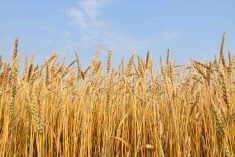A hard-to-control fungal disease that comes and goes in cereal crops has been on a rampage of late.
“Close to 30 percent of the hard red spring (wheat) in Alberta last year was downgraded due to ergot, so that’s a pretty significant level,” said Kelly Turkington, a research scientist with Agriculture Canada’s Lacombe Research Centre.
Ergot usually doesn’t pose nearly as much of a problem as other cereal diseases, such as fusarium and leaf spot diseases.
However, it can cause serious downgrading when it does arise because the ergot bodies contain mycotoxins, which can cause significant health problems in humans and animals.
Read Also

Growing garlic by the thousands in Manitoba
Grower holds a planting party day every fall as a crowd gathers to help put 28,000 plants, and sometimes more, into theground
Twenty-eight percent of red spring wheat deliveries in Alberta, 18 percent in Saskatchewan and 16 percent in Manitoba were downgraded in 2011 because of ergot contamination. The damage was 16 percent, five percent and eight percent in the previous year.
Wet weather in June and July of the last two years is the main culprit, which is why the disease was more prevalent in Alberta, where precipitation levels were 115 to 200 percent of average in June and July last year compared to 40 to 85 percent of normal in Manitoba.
Cooler temperatures in the western half of the Prairies contributed to increased disease pressure. Ergot infection happens during flowering, and cool weather extends the flowering window.
Researchers also blame the in-creasing popularity of the canola-cereal-canola-cereal rotation across the Prairies.
They used to believe a one-year hiatus from growing a cereal host crop would be sufficient to allow for natural destruction of pathogen inoculum in or on the soil.
“We’re starting to think, ‘well, maybe that’s just simply not long enough,’ ” said Turkington.
Unfortunately there is no silver bullet for managing ergot.
“It’s a difficult disease to control because we don’t really have resistance (built into varieties),” said Turkington. “We’re probably a ways off from that.”
Spraying with a fungicide is not recommended.
“You’re simply not getting the chemical to the tissues that you’re wanting to protect, which is the ovary tissue in that flower,” he said.
Instead, farmers need to adopt a holistic approach to disease management — from seeding right through to harvest.
Growers might want to consider using certified seed with low levels of ergot and increasing their seeding rates because a thin crop will have more tillering, which increases the potential period for infection.
Farmers will also want to keep a close eye on grasses growing along the margins, headlands or roadways adjacent to their fields.
Grasses are excellent hosts for ergot and should be mowed before heading to prevent a potential source of inoculum.
Copper and boron deficiencies can lead to pollen sterility, forcing normally self-pollinated cereals like wheat and barley to open their flowers to access pollen from adjacent plants.
That exposes the plant to ergot spores, infecting the female reproductive structures.
Copper has been promoted as a cure-all for ergot infection, but cool temperatures at heading and late herbicide applications can also cause pollen sterility.
Turkington said adding more copper or boron to a field that has adequate levels of the minerals doesn’t provide any more protection against ergot infection.
Crops that have ergot infection should be left out in the field longer than usual during harvest because the ergot bodies become loosely attached to the cereal heads and can be dislodged by strong wind.
Growers might want to harvest and bin the headlands of their fields separately because that is the area where infection is likely to be the greatest due to surrounding grassy areas.
Farmers can also use gravity tables and colour sorters to clean ergot bodies out of their grain if it proves economical.
Turkington said it remains to be seen how much damage ergot will cause this year.
There are definitely some hot spots where the inoculum undoubtedly exists in the soil, but the extent of infection depends on what the weather brings this summer.
Agriculture Canada plant pathologist Jim Menzies has identified a durum line with very good resistance to ergot.
The line is being used in a durum breeding program, and studies are underway to discover the genetics behind the resistance and identify molecular markers so the source of resistance can be used in plant breeding programs.


















